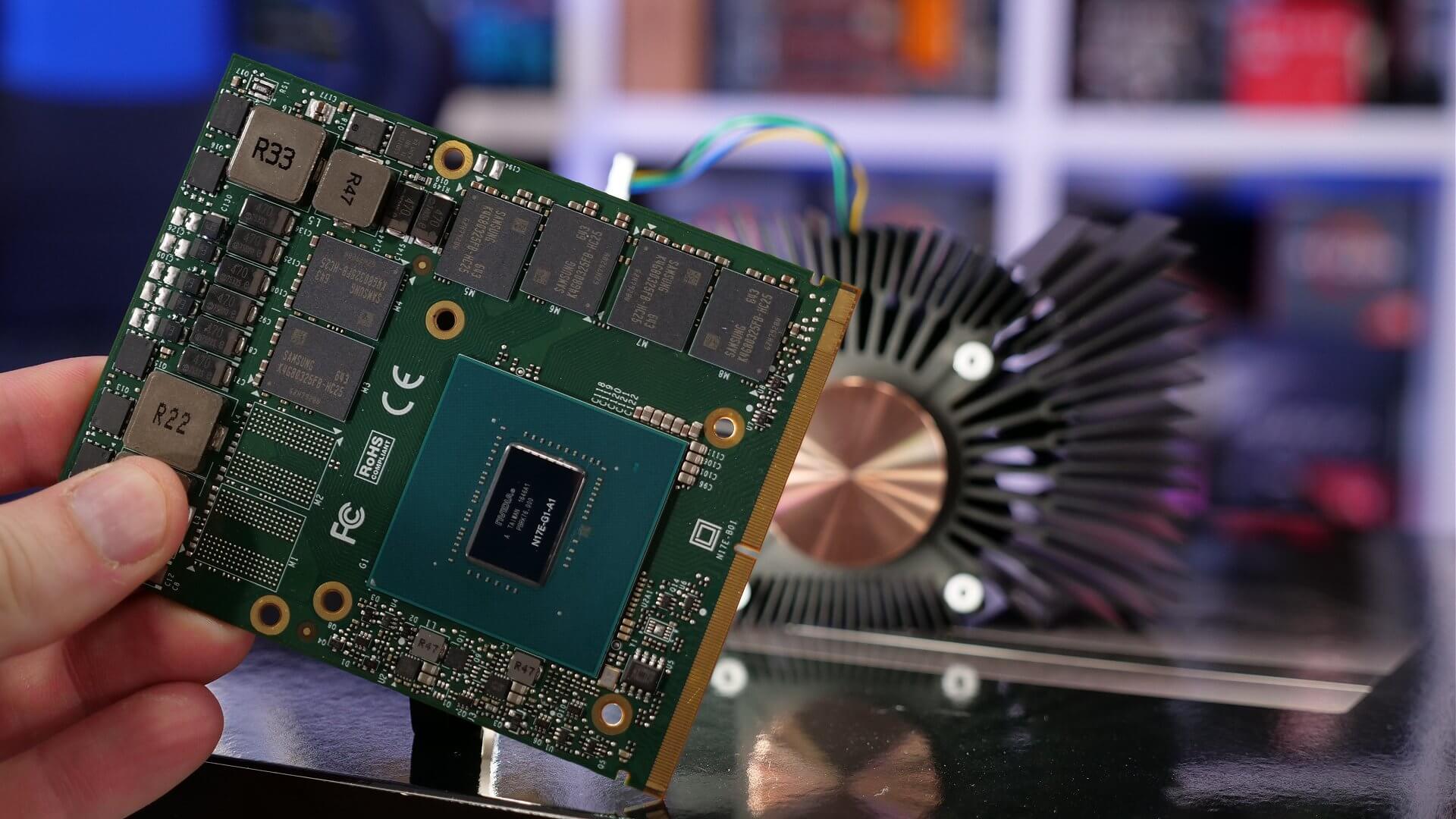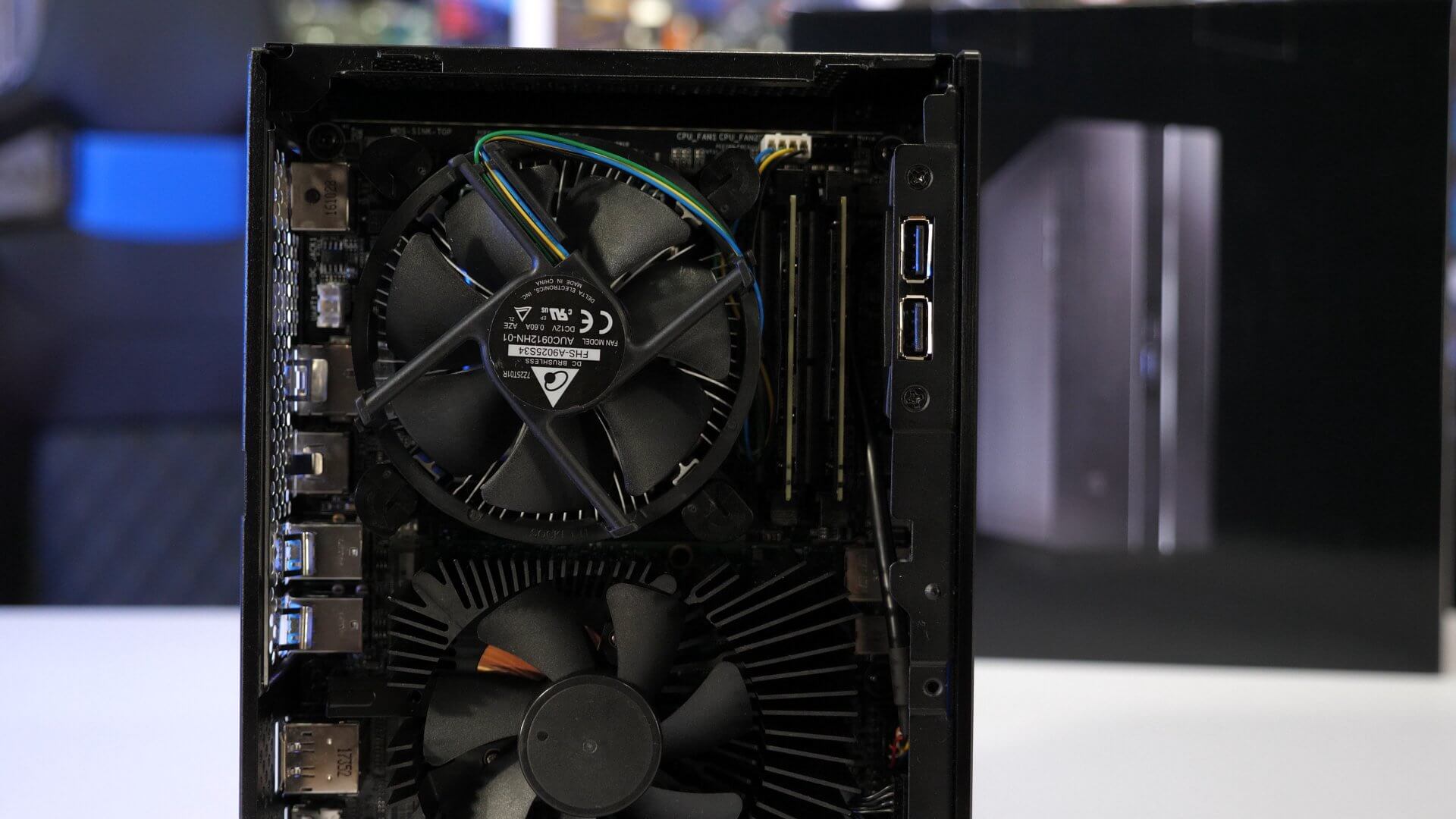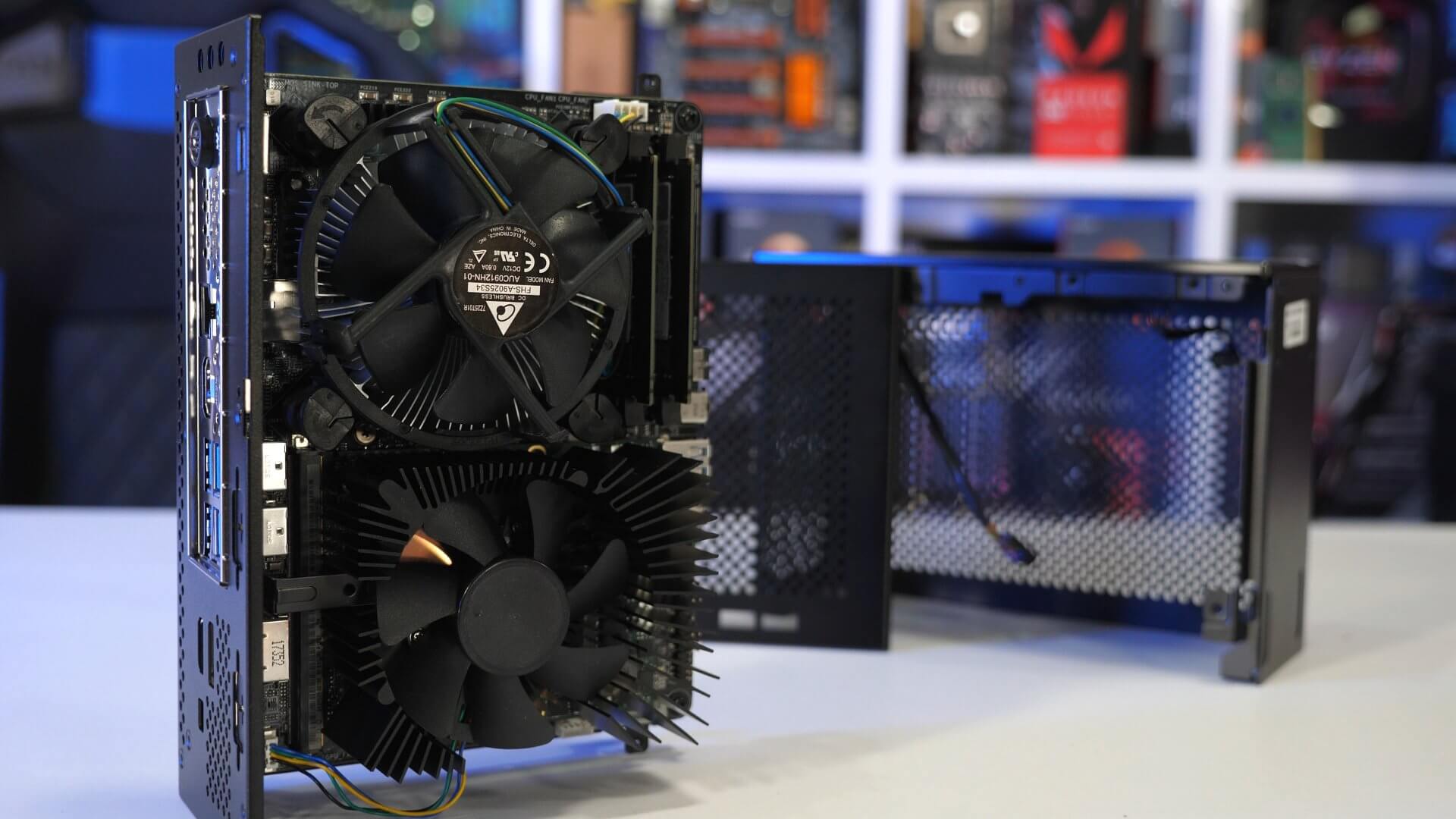Asrock DeskMini Z370 GTX 1060 Review
Today nosotros're checking out Asrock's latest DeskMini PC, a proper name that may band a bell if you've read our previous coverage on the original entry to this compact computer. The latest version that we take on hand today looks exactly the same as the last DeskMini and has the same name as the previous 2 DeskMinis.
The first DeskMini -- the DeskMini 110 -- was released in 2022 and sported a tiny 1.92L instance that housed an H110-based Micro-STX motherboard with support for 6th and then 7th generation Core processors. Notwithstanding, the DeskMini 110 was so small it couldn't actually handle a discrete graphics card, and then information technology was basically an office PC.
That state of affairs inverse concluding year as the series was updated with the DeskMini GTX/RX which features support for an MXM discrete mobile GPU that can exist installed cheers to a beefier B250 or Z270-based Micro-STX motherboard, which increased the case capacity to 2.7L merely still made for a very compact unit.

Now we have another new DeskMini GTX/RX, this time based on Intel'due south 8th generation Core series. To become around this confusion, retailers accept been putting the chipset in the product championship to brand information technology easier for shoppers to piece of work out which system they're actually buying.
The latest DeskMini Z370 comes with either an GTX 1060 or GTX 1080 in the MXM form-factor pre-installed. Alternatively, you can buy Asrock'southward organisation without a detached graphics carte simply be enlightened that securing a new MXM GPUs after the fact will be nigh impossible as they are not sold at retail equally you can generally only get them from salvaged laptops.
Currently there doesn't announced to be any DeskMini Z370 models on auction but Asrock says the MSRP for the GTX 1060 model is $850. The previous generation B250 DeskMinis are on sale and the GTX 1060 version costs a cool $800 with the GTX 1080 model priced at $one,500, so while the new Z370 models aren't that much more than expensive, $850 is getting toward the pricier side of things for this little PC and we're swell to see what more information technology offers over the previous versions.

Included in the package is the tiny two.7L case and a 220w external power brick that is quite a big volume itself at 0.7L, or 26% of the DeskMini's total size. Along with the case and power supply you lot likewise get a custom Z370M-STX MXM motherboard that'south 2" longer than your typical Micro-STX motherboard and this actress real-estate has been used to squeeze in an MXM slot supporting up to Type B+ cards at 113mm long. Because nosotros have the GTX 1060 DeskMini, ours naturally came with a GTX 1060 MXM graphics card pre-installed.
To become up and running yous'll need to bring your own Java Lake CPU besides as some DDR4 And then-DIMM memory and storage. Assuming y'all went with a Core i5-8400 ($180), 16GB of DDR4-2400 ($170) and a 512GB Samsung 960 Pro ($300) for example then you'd be pitching in an extra $650 on tiptop of the $850 for the DeskMini, bringing the total bill for the GTX 1060 model to at to the lowest degree $ane,450.
That's probably not as well bad when yous can expect to pay around $400 lonely for a GTX 1060, just we'll discuss pricing more at the finish of the review. For now let's have a await around the unit before checking out the hardware within.

Externally, the all-blackness case features a brushed aluminium forepart with clean lines. The circular power push button blends in nicely as does the front I/O which includes ii 3.5mm audio jacks, a Blazon-A and Type-C USB 3.1 Gen1 port.

Around back you get four USB 3.ane Type-A ports, an HDMI output and a Gigabit LAN connection, while a DisplayPort, mini-Displayport and HDMI output are connected to the GTX 1060. Then depending on how you orient the instance the are some other two USB ports on the side and although these are older 2.0 ports they are still handy for things similar the keyboard and mouse.
Removing the tiptop panel grants access to the CPU socket which sits next to the pre-installed MXM graphics carte du jour. The motherboard tray slides out of the case and once yous remove the front end I/O cables you can completely remove the tray and install your storage devices. Hither you lot will find the CMOS battery along with the Z370 chipset which is cooled courtesy of a small silver heatsink.
Annotation that the three Chiliad.2 Ultra ports are all PCIe 3.0 x4 capable and can support 2260 or 2280 cards, while at that place'south also a Yard.2 Wi-Fi port and you tin squeeze in a pair of 2.5" SATA 6Gb/south drives every bit well if you tin believe that.

On the forepart side we get a Realtek ALC233 codec and an Intel i219V Gigabit Ethernet controller. Delivering power to the CPU is a 5+1 phase VRM which is surprisingly capable though Asrock has limited back up for processors with a 65w TDP rating. The VRM heatsinks are tiny but do a surprisingly good chore as I found in my testing, even when working well in a higher place spec.

For testing nosotros've installed a Core i7-8700 processor, a pair of Team-Grouping'southward DDR4-2400 8GB modules and for storage 2 ADATA XPG GAMMIX S10 NVMe SSDs, sadly I only had the 128GB models on hand which I don't recommend you purchase as the 256GB and larger models are significantly meliorate value.
Installing all the hardware was relatively quick and easy. By default y'all'll be forced to use the Intel box cooler which is a shame merely with limited headroom there really aren't a huge amount of options hither. The Cryorig C7 might be the way to become hither for $xxx.

I did almost of my testing with the Core i7-8700 just I as well tried the Core i5-8400 and honestly this would be a improve pairing for most users. Information technology runs libation and therefore quieter with the box offering and you can also get the most out of the CPU.
Although it nonetheless runs within the Intel spec, the 8700 does bask a decent performance crash-land with a improve cooler. At kickoff I thought it was a ability delivery event but it turns out fifty-fifty a Cadre i7-8700K runs perfectly fine with an aftermarket libation installed, the cooler doesn't fit with the tiptop panel installed but I just wanted to see if nosotros were thermal or power express hither.
By default the DeskMini is configured with a maximum sustained turbo boost power draw of just 65 watts with a 1 second turbo boost short power peak of 81 watts. Asrock hasn't done this to salve their teeny tiny VRM but instead limit thermal output to stop the Intel box cooler sounding like a jet engine.

This limitation means that 8700 can only produce a Cinebench R15 score of 1125pts, which is around xx% lower than what you'd look to see in a desktop arrangement with a $x aftermarket cooler. If yous don't care most operating volume and then you can increase these limits, although information technology only boosted the Cinebench R15 score by around 5% while the operating volume increased significantly equally the fan speed picked upwards from 2100RPM under load to 3200RPM.
Later an hr long stress test the 8700 held a clock frequency of three.5GHz whereas the 8400 with the same box libation could maintain a 3.8GHz operating frequency. So over again, we recommend using the 8400 over the 8700 in the DeskMini.
When it came to gaming, I benchmarked one-half a dozen titles, but earlier nosotros get to the graphs hither'southward a quick await at some gameplay with on-screen statistics.
At stock the DeskMini's GTX 1060 hovered betwixt 1550 and 1600MHz and peaked at 72 degrees. The CPU wasn't heavily utilized in this test so it was able to maintain a 4.3GHz operating frequency fifty-fifty though the temps were often very high, getting upward to 82 degrees at times.
Overclocked with the CPU limits removed too equally the GPU core and memory overclocked, the GPU cores ofttimes sat at effectually 1.7GHz while the memory was now skillful for viii.8Gbps up from 8Gbps. The CPU once more hit 82 degrees at times but mostly sat around 70 degrees, as did the GPU. Equally you lot might expect, the DeskMini was quite loud when overclocked and probably not worth the extra 5% bump in performance seen in this stress test.
Benchmarks
Beginning up we have Battlefield 1 and hither the DeskMini had no trouble delivering highly playable performance at 1080p using the ultra quality preset. As expected, it was a scrap slower than a desktop PC sporting the Founders Edition model...

The 1% low effigy was 12% lower while the average frame rate was just 4% lower and the reason for this is the lower clocked DDR4-2400 memory while the desktop system uses the Core i7-8700K clocked at 5GHz with DDR4-3200 memory.
So keeping that in mind, the DeskMini does very well and with a piddling tweaking is able to roughly match the desktop rig. Of course, a custom board partner model such as the Gigabyte Aorus GTX 1060 6G 9Gbps is a bit faster once again just overall the DeskMini holds up.

The system's performance in Dirt 4 is very similar. Over again, pairing the DeskMini with faster DDR4 memory really helped boost the 1% low figure and with a little actress tinkering we were getting full blown desktop gaming PC functioning.

Here we see when testing with Ghost Recon Wildlands that the stock DeskMini does struggle quite a bit at 12% slower than the GTX 1060 FE carte in our exam system. That said, faster retention and a footling tweaking to the settings reduced that margin to just 5%.

Mass Effect Andromeda saw the DeskMini trail by a pocket-size margin even when overclocked or rather tweaked with faster memory and a more aggressive power contour.

It was a similar story when testing with Prey, that said with well over 60fps at all times using the highest quality settings at 1080p it was hard to complain with the results.

Out of the box, the DeskMini looked quite weak in Titanfall 2 and I know memory speed really helps in this title and so that DDR4-2400 retentiveness would accept been limiting performance here. As a result, nosotros saw a rather large 12% uplift for the one% low effect when moving from 2400 or 3200 memory.

A big advantage of the Asrock DeskMini is power consumption. The organisation'due south low output enables very depression consumption when at idle, just 30 watts in fact. Ability consumption increased nether load and wasn't that far from the ability brick's 220w maximum output. That said, it did use 20% less power than our test system equipped with the 1060 Founders Edition model.
Wrap Up
We've taken a proficient wait at the new Asrock DeskMini GTX 1060 and it's safety to say that when information technology comes to non-gaming tasks, the machine should be rather capable depending on what CPU y'all put in there (anything slower than the Core i5-8400 would be a poor pick given how much this barebones kit costs). Judging past the handful of titles nosotros tested, the new DeskMini can handle some moderate PC gaming as well, although if you ask u.s. the system seems meliorate suited to content creators looking for a super compact editing rig.
The Cadre i7-8700 offers loads of performance simply to go the most out of it y'all will need to upgrade the cooler and your options here are express. For most, the deviation between the Core i5-8400 and Core i7-8700 in the DeskMini is going to be minimal and then we recommend going with the cheaper Cadre i5 model.

Asrock says it'south targeting LAN Party goers, Esport gamers and content creators with its updated DeskMini and the tiny ii.7L capacity coupled with GTX 1060 certainly makes the package ideal for gamers on the movement, though that's probably a very niche market these days. Esports games are obviously pop simply more often than not speaking competitive gamers seek maximum bang for their buck, making the DeskMini somewhat of a tough sell to this crowd compared to a more professional market.
The only real issue that we see is with the automobile's $850 asking price. Granted, GPU prices are ridiculous at the moment simply nevertheless you can often snag a GTX 1060 6GB for about $400. Then a Mini-ITX Z370 board costs about $140, quality Mini-ITX cases that can back up full size graphics cards start at $fifty and SFX power supplies as well begin around $50. In other words, you're paying effectually $200 actress for the DeskMini'due south ultra compact design.
That's a hefty premium simply nonetheless the Z370 DeskMini GTX 1060 is an impressive little calculator capable of just about any typical computing chore. It'southward just that it only actually makes sense if you lot want the smallest possible PC with a discrete graphics menu, and withal, GTX 1060-enabled laptops with a quad-cadre Cadre i7-7700HQ processor start at around $1,000, and that makes more sense to me equally you basically get a 15.half dozen" screen and a battery thrown in for free, so keep that in mind.
Pros: Great looks, good performance. Super compact (2.7L). Supports desktop CPUs and MXM GPUs including the GTX 1060 and 1080.
Cons: Expensive. Await a ~$200 premium to build around this barebones kit versus going truly DIY (though this would be less meaty).
Source: https://www.techspot.com/review/1585-asrock-deskmini-gtx-1060/
Posted by: pagansatedilly.blogspot.com



0 Response to "Asrock DeskMini Z370 GTX 1060 Review"
Post a Comment